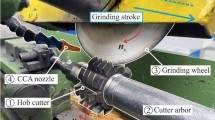Abstract
This paper investigates the cooling effect when using an air jet at sub-zero temperature of −15 °C in the plunge grinding of a cylindrical component made of high strength steel EN 26. A three-dimensional finite element heat transfer model with a moving heat source was developed to reveal the complexity of the heat transfer mechanism involved. It was found that the use of cold air does not significantly reduce the temperature rise in grinding and that the cooling effectiveness is mainly limited by the following facts: (a) the air jet is difficult to penetrate into the grinding zone, (b) the heat transfer coefficient provided by an air jet is small and (c) cooling is limited by the time which the rotating workpiece surface can be exposed to the jet impingement. The study also showed that the present modelling method can be used as a first tool to assess the feasibility of a new cooling medium for grinding operations.
Similar content being viewed by others
References
Malkin S, Guo C (2008) Grinding technology—theory and applications of machining with abrasives, 2nd edn. Industrial Press, New York
Skerlos SJ, DeVor RE, Kapoor SG (1998) Environmentally conscious disposal considerations in cutting fluid selection. ASME International Mechanical Engineering Congress and Exposition, Proceedings of the ASME: Manufacturing Science and Engineering Division, Med-Vol 8, Anaheim, CA, pp 397–403
Paul S, Chattopadhyay AB (1995) A study of effects of cryo-cooling in grinding. Int J Mach Tools Manuf 35(1):109–117
Nguyen T, Zarudi I, Zhang LC (2007) Grinding-hardening with liquid nitrogen: mechanisms and technology. Int J Mach Tools Manuf 47(1):97–106
Suzuki K, Isonami H, Uematsu T, Iwai M, Funazawa T (1999) An attempt of dry ice jet coolant in CBN grinding. In: Wang J, Scott W, Zhang LC (eds) The 3rd Int. Conf. on Abrasive Tech. (ABTEC'99), Brisbane, Australia. World Scientific, pp 400–403
Nguyen T, Zhang LC (2003) An assessment of the applicability of cold air–oil mist in surface grinding. J Mater Process Technol 140(1–3):224–230
Nguyen T, Zhang LC (2010) Grinding-hardening using dry air and liquid nitrogen: prediction and verification of temperature fields and hardened layer thickness. Int J Mach Tools Manuf 50(10):901–910
O’Donovan TS, Murray DB, Torrance AA (2005) Jet heat transfer in the vicinity of a rotating grinding wheel. J Mech Eng Sci 220(6):837–845
Fricker DC, Pearce TRA, Harrison AJL (2004) Predicting the occurence of grind hardening in cubic boron nitride grinding of crankshaft steel. Proc Inst Mech Eng B J Eng Manuf 218:1339–1356
Incropera FP, Dewitt DP (1990) Fundamentals of heat and mass transfer, 3rd edn. John Wiley & Sons Inc., New York
Zarudi I, Zhang LC (2002) A revisit to some wheel–workpiece interaction problems in surface grinding. Int J Mach Tools Manuf 42(8):905–913
Shaw MC (1996) Principles of abrasive processing. Oxford University Press, Oxford
Malkin S, Anderson RB (1974) Thermal aspects of grinding. Part 1: energy partition. J Eng Ind Trans ASME 96:1177–1183
Malkin S, Guo C (2007) Thermal analysis of grinding. CIRP Ann 56(2):760–782
Kohli S, Guo C, Malkin S (1995) Energy partition to the workpiece for grinding with aluminium oxide and CBN abrasive wheels. Trans ASME 117:160–168
Malkin S, Koren Y (1984) Optimal infeed control for accelerated spark-out in plunge grinding. J Eng Ind Trans ASME 106:70–74
Dong S, Danai K, Malkin S, Deshmukh A (2004) Continuous optimal infeed control for cylindrical plunge grinding. Part 1: methodology. J Manuf Sci Eng 126:327–333
Jakob M (1949) Heat transfer, vol 1. Wiley, New York
Martin H (1977) Heat and mass transfer between impinging gas jets and solid surfaces. Adv Heat Tran 13:1–60
Gau C, Chung C (1991) Surface curvature effect on slot-air-jet impingement cooling flow and heat transfer process. Trans ASME 113:858–864
Zuckerman N, Lior N (2006) Jet impingement heat transfer: physics, correlations, and numerical modeling. Adv Heat Tran 39:565–630
Marinescu I, Hitchiner M, Uhlmann E, Rowe WB, Inasaki I (2007) Handbook of machining with grinding wheels. In: Boothroyd G (ed) Manufacturing Engineering and Materials Processing, A Series of Reference Books and Textbooks. Taylor & Francis Group, CRC Press, Boca Raton, FL
Woolman J, Mottram RA (1966) The mechanical and physical properties of the British Standard En steels (B.S. 970–1955). Pergamon Press, Oxford
Lavine AS, Jen TC (1991) Thermal aspects of grinding: heat transfer to workpiece, wheel, and fluid. Trans ASME 113:296–303
Nguyen T, Zhang LC (2005) The coolant penetration in grinding with segmented wheels. Part 1: mechanism and comparison with conventional wheels. Int J Mach Tools Manuf 45(12–13):1412–1420
Nguyen T, Zhang LC (2006) The coolant penetration in grinding with a segmented wheel. Part 2: quantitative analysis. Int J Mach Tools Manuf 46(2):114–121
Bird RB, Stewart WE, Lightfoot EN (2001) Transport phenomena. John Wiley & Sons, New York
Author information
Authors and Affiliations
Corresponding authors
Rights and permissions
About this article
Cite this article
Nguyen, T., Liu, M. & Zhang, L.C. Cooling by sub-zero cold air jet in the grinding of a cylindrical component. Int J Adv Manuf Technol 73, 341–352 (2014). https://doi.org/10.1007/s00170-014-5819-2
Received:
Accepted:
Published:
Issue Date:
DOI: https://doi.org/10.1007/s00170-014-5819-2




